A Curvilinear Brain-Bender
-By Todd Lockwood
I had a new experience of Curvilinear Perspective recently, something that has always fascinated me. Circumstances combined to show me the answer to a visual riddle, one I’d observed and puzzled at before. The answer was something I essentially grasped, but this was the first time I’d had opportunity to actually study it and make it make sense.
This particular morning I had to take my wife, Rita, to the airport very early; we left about 3:30 am. The sky was clear, and there was a 3/4 moon hanging low in the southern sky. It looked more or less exactly like this:
What struck me immediately is that it seemed to be peering upward, based on the simple geometry of light and how it strikes objects. That’s not the axis of the moon, it’s the axis of the terminator of light, as determined by the trajectory of light required to put the shadow line where it is:
BUT … the sun wasn’t up yet.
Stretch this image out left to right until it encompasses about 180° and you’ll get the picture. You would have to turn your head to look from impending sunrise to setting moon:
The sun was yet to come up, far north of due East , yet the 3/4 moon in the southwestern sky (almost 180° away) was clearly tilted upward. That puts a kink in your thinker.
So what was going on?
The explanation comes in perception and the rendering of perspective from a 3D universe into 2 dimensions, and how our conventions muddy our expectations.
Consider for a moment that you’re standing on the centerline of a four lane highway. It’s perfectly flat and perfectly straight. You look left, and all the parallel lines of center and either margin converge toward a vanishing point. You look right and they do the same thing. You know that those lines are all parallel; they’re all straight. You would probably render either view with straight lines. And yet they all bend toward each other at opposite horizons. They’re not straight … or are they?
That’s Curvilinear Perspective. The problem comes in translating something 3 dimensional onto a plane that is flat; 2D art doesn’t perfectly render reality.
Which line is straight?
The one you’re looking at!
Or, they all are, but none of them are …
Our view of the universe is, in a real sense, like a fish-eye photo. Your field of view is a sphere, not a flat plane. But we fail to notice, in part because of our inability to see it all at once, and in part due to the psychology of perception derived from the fact that our visual organs and the cortex that interprets their data focus on the center … but also because we have been taught a formal way of interpreting the universe that insists on straight lines.
We tend to draw what we perceive in the center most area of our retina; our peripheral vision is an addendum. We rarely consider what’s going on outside our center of focus unless it looks like it might eat us.
If you really concentrate on what’s in your periphery without turning your head, you can see this curvature in the room you’re in now, in the lines where wall meets ceiling and floor, and any piece of furniture parallel with them. Or stand in a narrow room like your powder room, two feet from the narrowest wall; look down and see the left and right margins of the wall receding toward a vanishing point below the floor. Now look up and see the same two parallel margins converging toward the opposite vanishing point above the ceiling. Those lines are ultimately curved, because they have to meet at one of two vanishing points on either side of you.
You reside at the intersection of every pair of opposed vanishing points. In the drawing below, A and B are two possible vanishing points for a set of parallel horizontal lines. C and D are the vanishing points for any sets of parallel vertical lines. The blue lines represent parallel lines receding toward either vanishing point (like the line where your walls meet the ceiling or floor). The red line represents a vertical line taken all the way to either vanishing point. From the intersection of those axi – your position in space, the real world, where you reside at the center of your field of view – those lines all appear straight.
As soon as we take a piece of that world and flatten it onto a 2 dimensional canvas, we’re forced to tell a little lie. In art, we either choose one line in a set of parallels to be straight, and bend the rest, or we lie for the sake of convenience and make them all straight with a perspective grid. You may have seen this in photos of rooms in Better Homes and Gardens or Architectural Digest, where a tilt-lens camera has been used to distort all the verticals in a shot and keep them vertical in the image; it has the effect of stretching that square table in the corner of the picture into an unnatural shape. The same thing happens if you draw that table in the corner of the picture using a simple one-point perspective grid, keeping vertical elements “vertical” on the page.
It even happens if you use a three-point perspective grid. Distortions will become pronounced as you move away from the center.
Which lines are bent? The ones you’re not looking at!
In the case of the moon and the sun that morning, there were two critical straight lines in the image: the very solid and obvious virtual straight line of the horizon (actually, a plane that I’m seeing edge on in every direction), and the invisible but very real straight line representing the path of the sun’s light toward the moon. Most artists (me included) would have rendered the scene as you see it above. But having picked the horizon to be the “straight” line, this is the lie I tell:
That dotted line represents a straight line. We know that because light travels in a straight line. I might also have rendered that scene like this:
But now I’ve transferred all the distortion onto the horizon. That totally bends your brain at 4 in the morning, when you’re trying to watch the highway AND picture the perspectives in your head, and see if that horizon line is bending in your peripheral vision when you look at the moon (it is. Sort of. Except no it isn’t):
Here’s more or less the arrangement of sun, moon, earth, and me in space:
The sun is out of sight beyond the terminator of light and shadow. The moon was low in the sky because I was basically looking over the shoulder of the earth toward its orbit below the plane of the equator. But I’m looking “up” at it in my hemisphere of sky.
If I had painted it in the fishbowl, it would have looked something like this:
The sun is out of sight below the horizon, just off my left shoulder. With my eyes in the sweet spot, the center of my field of view, all the dotted lines are straight.
The only way I could render this scene without distorting something, somewhere, would be to paint it on the inside of a perfectly spherical bowl, with my eyes in the sweet spot. See above. I’d have to turn my head to see it all. Failing that, as an artist I have to edit reality in a way that gives the best representation.
In the end, does it matter if we understand things that only happen out in the wilderness of our peripheral perception? I think so. When you get it, those tables in the corner of the image won’t be distorted by your perspective grid. They’ll look “right.” The ellipses on the top of the towers in your vertigo-inducing castle-scape will read correctly. You’ll know better how to edit reality to give the best illusion.
I’ll give examples tomorrow in Curvilinear Perspective, Part 2.


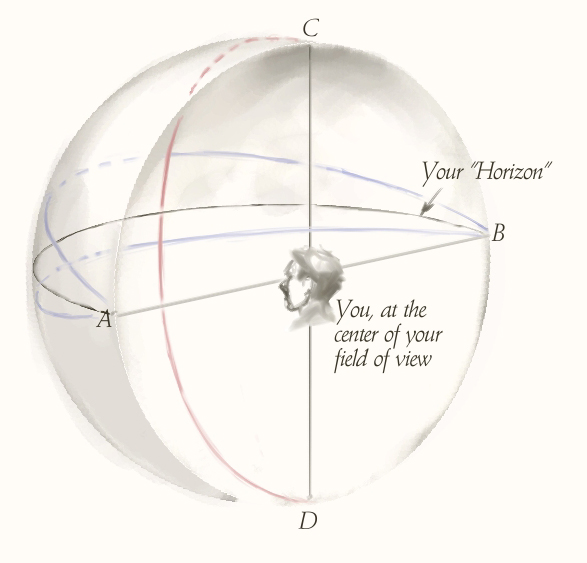


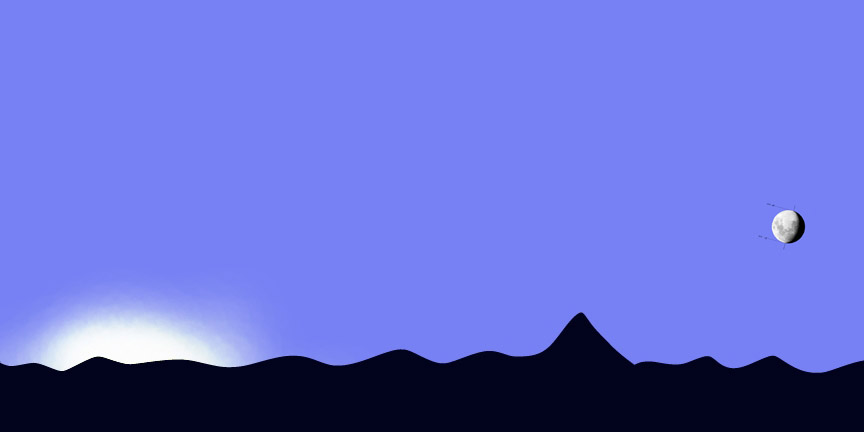

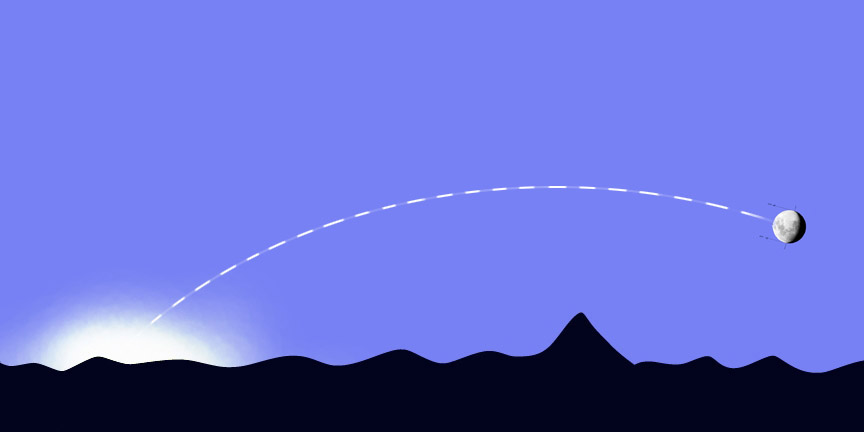

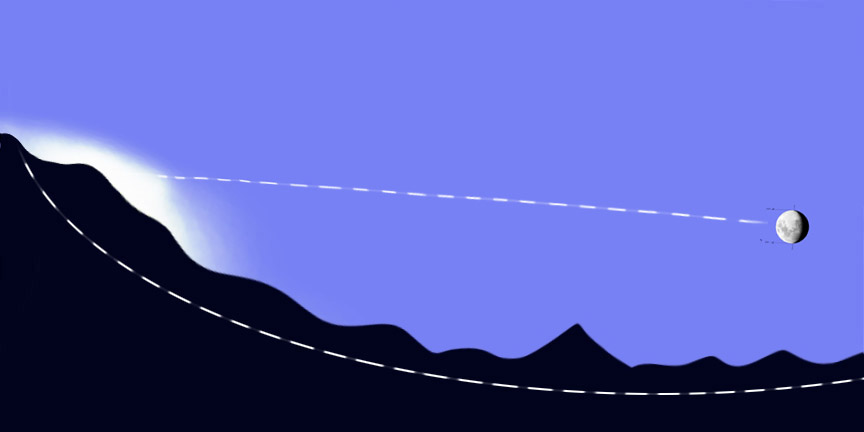
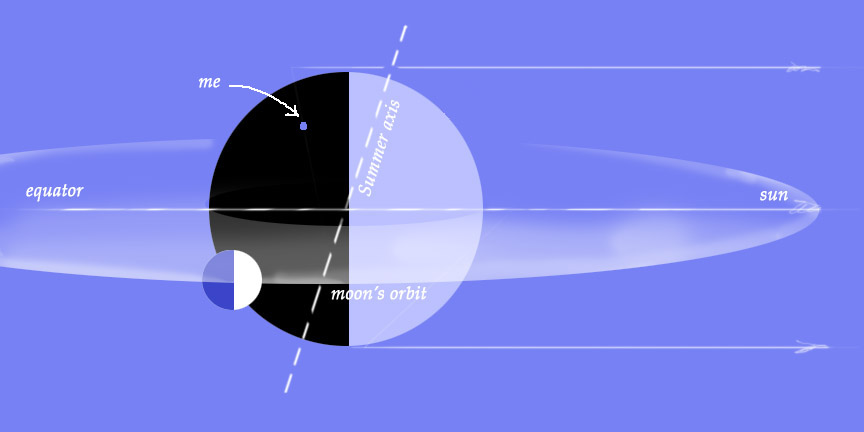
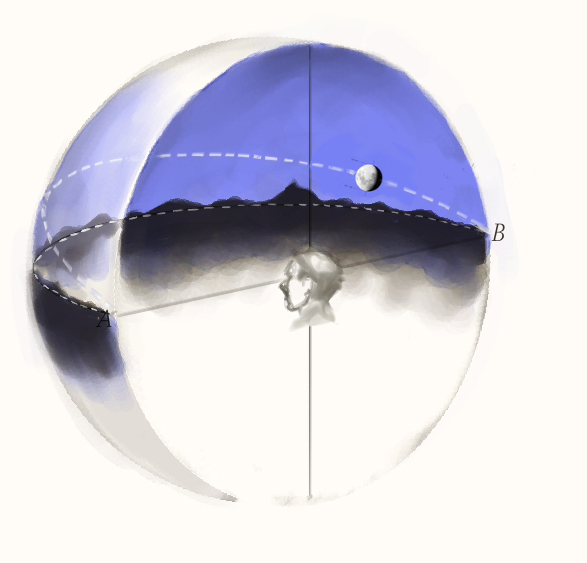
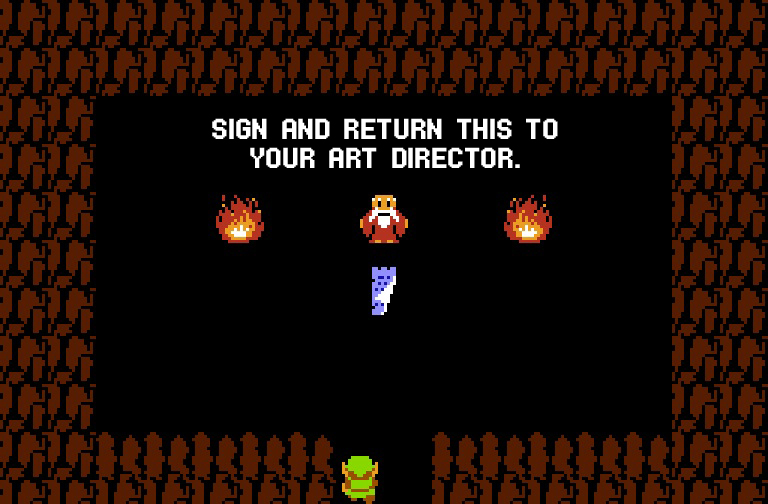
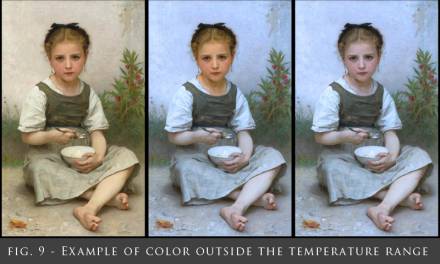
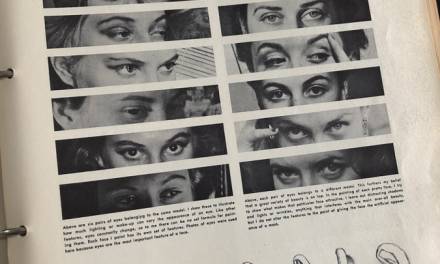

Such an amazing post, Todd! So interesting, I never noticed that about the light hitting the moon, now I believe I'll be looking at the moon more often to catch this for myself 😉
Whenever I've questioned this phenomena, I've been told (admittedly by scientists rather than artists) that the Earth's atmosphere refracts the light from both the sun and the moon creating a distorted perception of their relative positions in space. This theory works along the lines of how a goldfish living in a spherical bowl might view the world outside. Light passes through the bowl at a different angles depending on the viewpoint and direction thus creating a distorted image – that could explain why goldfish always look perplexed. I particularly like your line 'we lie for the sake of convenience'. Great Post.
Great to see you posting on here and insightful as always!
“our conventions muddy our expectations”
A great line for this blog! Fascinating post, Todd. You're a renaissance man.
-Chris
Great post, nice and insightful.
When I thought of this in my astronomy class I wondered if your position latitude effected the angle of the moons shadow. I also wonder if the moons position in relation to the apex would also have an effect.
Thanks for reinvigorating my wonder lust.
Thank you for this interesting post. I appreciate the time you took to break this down.
Here is a nice flash animation to accompany your fish bowl painting:
http://astro.unl.edu/classaction/animations/lunarcycles/positionsdemonstrator.html
Try: latitude = 42 deg, sun position #1, moon position #4, and then 'show phase on moon disc'.
ooh, i cant wait for #2 🙂 many thanks already!
i, too, always found curvilinear perspective interesting, yet, to my dismay, even perspective books that claim to be “complete” stopped at 3 vanishing points. so all i know about it is from the snippets you find here and there, and observation, of course.
i like the visualization with the spherical canvas – my own figure of thought implied that each shift in gaze direction shifted vanishing points for that cone of vision as well – therefore a “complete” depiction must have shifting vanishing points for each point in the painting.
of course, that raises the question what kind of painting will profit from using curvilinear perspective. it seems to imply a shift in gaze direction, thus, the role of an observer and having the time necessary to look at different parts of the picture.
This is a post that James Gurney will love!
Thanks for insight.
My head is spinning… in a good way!
Peter; Scientists don't spend their lives studying visual perception except for a very few, and I doubt that many of those are also artists. :o) Just sayin.'
Atmospheric distortion might shift the apparent altitude of sun or moon by a small amount, but it doesn't tilt the moon in its axis! That requires another explanation.
I like how the link that Johnnyburn added with the specs he input reinforces the visual understanding. Great addition! Thanks!
Raphael: bang on. Part of using curvilinear perspective in your grid is deciding which line to present as the “straight” line. Chances are it will be near your center of interest. The rest will possibly (but not necessarily) be bent, as you'll see tomorrow!
Or in other words: which line is bent? The one you're not looking at!
I love how your brilliant mind informs all the work you do. There's much more to your work than meets the eye! Love ya bro.
This morning I was out in the garden. I found a long, straight stick of bamboo and on impulse held it out at arms length, crosswise, at about a 42° angle. Not only did it look straight to my eye, but it touched either horizon. If I had had a straight stick of bamboo in the car with me. it would have been so much simpler …
Pifalo is right: I love it. You've bent my brain and busted my assumptions. Fantastic posts, Todd. More, more!
Very nicely explained, I've been trying to find away of explaining this to other people, you do it so well. Know anything about non-euclidean geometry? How the angles in a triangle don't add up to 180 degrees when you can't see all the triangle at the same time? because even though they're both linked I can't find anything, just about drawing an enormous triangle across the surface of the earth
But why is the moon upside down? Tycho should be toward the bottom (right-bottom at moonrise, left-bottom toward moonset… or at least it was last night and this morning!)
I understood this from the moment we started to study two point perspective. The problem is that I didn't know how to render this, until I discovered how to do curvilinear perspective. Now I'm practicing on it.
Thank you so much Todd! I just tried drawing a straight line on a spherical glass bowl between two points, moved the bowl in relation to my line of vision and the moon-effect appears! I can tell my son why the moon and sun don't line up now 🙂
Excellent!
It's the speed of light. The Sun appears only 8 minutes after we see the Moon illuminated by its photons. During those 8 minutes the Sun seems to travel an arc. So we see the Sun and the Moon at different points in time.
I noticed this occurrence with the sun and moon a few years ago and it has confused me since. I thought it might be the 8 minute light speed thing but the angles are to big for that to make sense. The sun doesn't move that fast across the sky in 8 minutes. I tried an experiment tonight with a round tumbler glass. I put a torch light pointing at a balloon and looked through the inside of the tumbler and the appearance was the same as the sun and the moon. The angle of the light on the balloon was not perpendicular to the torch as with the sun and the moon. This seems to be the best explanation – the fish bowl effect.
Excellent article but I've got some questions: Is the moon sun effect caused by 3 dimensional perspective illusion as in vanishing points on the highway or because space itself is actually curved? In other words, if you were to look through a fishbowl from the inside, and the bowl had parallel lines positioned horizontally like latitude lines on a globe of the world, the lines would remain parallel would they not? They would remain parallel as you turned from one point of the globe to the other because your distance from the lines wouldn't change. What makes lines in a road converge in the distance is the fact that you're farther away from them. Is the moon / sun effect created by the fact that space itself is curved and that at great distances the curvature of space is visible to the eye? And because we sit at a viewing angle that is not squarely perpendicular to a straight line from the moon to the sun? Thus causing the offset in their relative positions?
Are you still reading this Todd?
Geez! I hate this gray text on gray! I’ll compose in Word and Paste here…
I saw this “moon-pointer” illusion myself years ago and didn’t look into it until I saw something from some flat Earth debunker.
This is certainly a 3D, 2D, projection, perspective, vanishing point, perception problem.
Your drawing of a head in the sphere is ok and expresses the concept in a 2-D form but can still be confusing. If you make the line at its closest point appear higher up, perhaps 45 degrees or more, it is better. However this doesn’t happen “on” a sphere, so that image can also be confusing.
Though I am an experienced engineer, all this talk about Curvilinear Perspective appears to be correct, but I’m not familiar with those words to have them mean anything to me. I do understand perspective and I “get it”, the following demo allows anyone to wave an arm around and see what is happening pretty quickly.
There is a very simple demo that anyone can actually experience that can make this immediately obvious to anyone.
Stand about 2-3 feet away but directly facing a wall; the longer the wall the better – one end of a hallway can be very good. You must have a pretty clear view of the ceiling-wall joint. This is now a horizontal line that is about 4 feet above you and at 45 degrees above level. It is clearly straight and completely horizontal.
Now extend a straight, stiff arm out and up to point at the nearest point of the joint in a nazi-like salute with a flat palm downward so the thumb-pinky hand sort of mimics the line.
Step One to see true the geometry.
Without turning your body, Swing your stiff arm and head to one side to follow that line and try to continue that pointing out to the vanishing point. Your arm will be horizontal to your side as will be your gaze. The vanishing point is at your private, local horizon…always. This clearly mimics you head-in-sphere diagram.
Step two to grasp the illusion. Starting at the original nazi-like salute, hold your shoulder joint rigid, pointing upward, but now rotate your whole, STIFF body and arm (shoulder joint locked in position). You are pointing way above the vanishing point! This is what your brain told you to believe. This all works because the moon is up at an angle and the sun is really far away; essentially “at” the vanishing point.
Carrying this to the extreme would start with the moon over-head.
Although flat Earthers don’t “do” geometry, this is one of the proofs that the sun is far away.
– –
Regards, Steve Noskowicz
Good to know that works too! It was perfect the first time. I learn so much from you as well! Wow great post.